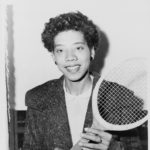The Green Book was a guide created by and for African Americans in the 1930s through 1960s to safely find everyday amenities like restaurants and hotels during a period of intense institutionalized racism across America. Over 100 sites were listed in the Green Book in Maryland including The Blue Star Motel and The Blue Jay Hotel in Southern Maryland.
Blog Series: This essay is one of a six-part series on Green Book history from the research of architectural historian, Anne Bruder and adapted by Anthony Plaag, a Waxter Intern at Preservation Maryland. Learn more about the project in this kick-off interview with Anne Bruder.
Every road tripper and vacationer looks forward to kicking their feet up at the end of a long day of travel and just relaxing. Lodging is an important part of any journey and Jim Crow-era segregation made lodging exponentially harder for Black Americans looking for a place to stay. The Blue Jay Motel and the Blue Star Motel provided places to stay for those traveling through Southern Maryland. Southern Maryland was not a popular tourist destination until shortly after World War II when Charles County legalized slot machines and became known as Maryland’s Little Vegas.
THE BLUE JAY MOTEL
The Blue Jay Motel used to be located on US Highway 301 in Waldorf, MD and was listed in the Green Book from 1956 through 1964. Arthur Farrar, the owner of the Blue Jay Motel, opened the Blue Jay as a means of providing black folks a place to stay. Before he built the motel, Arthur built a baseball stadium in the 1940s. He had a team called the B.B.’s (or Big Boys which was also the name of his gas station) all in north Waldorf. In 1952, the State Roads Commission purchased right-of-way from Arthur to build a new alignment for US 301 (Crain Highway) on the west side of Waldorf. It cut through the baseball stadium, but Arthur used the money and constructed the motel. Arthur moved from Washington to Waldorf in 1939 and opened the Blue Bird Inn.

 The Blue Bird Inn, was listed in the Green Book only in the 1955 edition, was a restaurant that had a few spare rooms for black travelers looking for a place to stay. Some of their guests include Noble Sissel, an American Jazz composer, and Althea Gibson, an American tennis player and professional golfer. Unfortunately, the Blue Jay Motel is no longer in operation and the former location of the building is now a national chain.
The Blue Bird Inn, was listed in the Green Book only in the 1955 edition, was a restaurant that had a few spare rooms for black travelers looking for a place to stay. Some of their guests include Noble Sissel, an American Jazz composer, and Althea Gibson, an American tennis player and professional golfer. Unfortunately, the Blue Jay Motel is no longer in operation and the former location of the building is now a national chain.
THE BLUE STAR MOTEL
The Blue Star Motel, also located on US Highway 301, was another motel listed in the Green Book in 1957, a year following the Blue Jay’s first listing. Furthermore, the Blue Star remained in the Green Book until 1964 and provided lodging for black travelers journeying from Virginia. Located just 6 miles North of the Potomac River Bridge, the Blue Star Motel was located in Faulkner, a predominantly African American community located in the Southern part of Charles county. This likely means that the Blue Star Motel was located in an area that would have been hospitable to Black motorists and probably would have had other locations for black travelers to patronize. The Blue Star Motel was renamed the Charm Motel in 1970.
Ultimately, The Blue Jay and Blue Star Motels provided safe and quality lodging for black tourists traveling US Highway 301 through Maryland.
EXPLORE GREEN BOOK SITES IN MARYLAND
- Introduction to Green Book sites in Maryland
- The CYMCA and the CYWCA in Baltimore City
- The Watson Tourist Home in Baltimore City
- The Harmon Hotel on Jonathan Street in Hagerstown
- The Blue Star Motel and The Blue Jay Hotel in Southern Maryland
- The Makel, Grinage, and Roberts Tourist Homes in Frederick
With assistance and upon the foundational research of Anne Bruder, this post was written by Anthony Plaag in his senior year of an undergraduate degree in Public History with a minor in Religion from Stevenson University. Anthony is interested in the intersections of History and Social Justice and believes history can be used as a tool for the liberation of marginalized and oppressed communities. Along with his writing about The Green Book in Maryland, he will also be assisted with Preservation Maryland’s LGBTQ history project. In his free time, Anthony likes to listen to the sweet stylings of Frank Sinatra, hanging out with friends, and discussing religion, philosophy, politics, and history.
